1996 CADILLAC ELDORADO high beam
[x] Cancel search: high beamPage 92 of 354
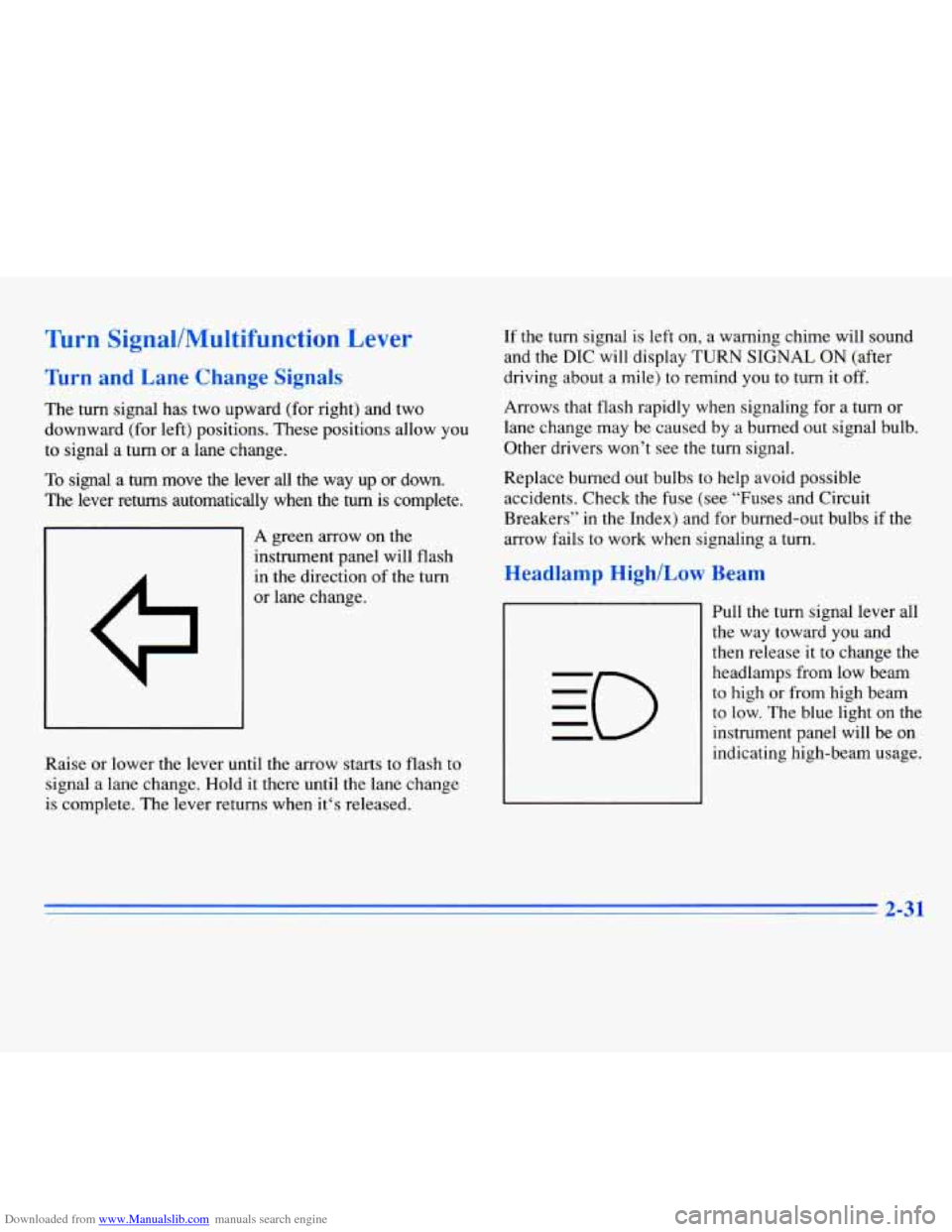
Downloaded from www.Manualslib.com manuals search engine Turn SignallMultifunction Lever
Turn and Lane Change Signals
The turn signal has two upward (for right) and two
downward (for left) positions. These positions allow you
to signal a turn or a lane change.
To signal a turn move the lever all the way up or down.
The lever returns automatically when the
turn is complete.
A green arrow on the
instrument panel will flash
in the direction of the turn
or lane change.
Raise or lower the lever until the arrow starts
to flash to
signal a lane change. Hold it there until the lane change
is complete. The lever returns when it‘s released. If
the turn signal is left on, a warning chime will sound
and the DIC will display TURN SIGNAL ON (after
driving about a mile) to remind you to turn it
off.
Arrows that flash rapidly when signaling for a turn or
lane change may be caused by a burned out signal bulb.
Other drivers won’t see
the turn signal.
Replace burned out bulbs
to help avoid possible
accidents. Check
the fuse (see “Fuses and Circuit
Breakers” in the Index) and for burned-out bulbs
if the
arrow fails to work when signaling a turn.
Headlamp High/Low Beam
Pull the turn signal lever all
the way toward you and
then release it to change the
headlamps from low beam
to high or from high beam
to low. The blue light on the
instrument panel will be on
indicating high-beam usage.
2-31
Page 93 of 354
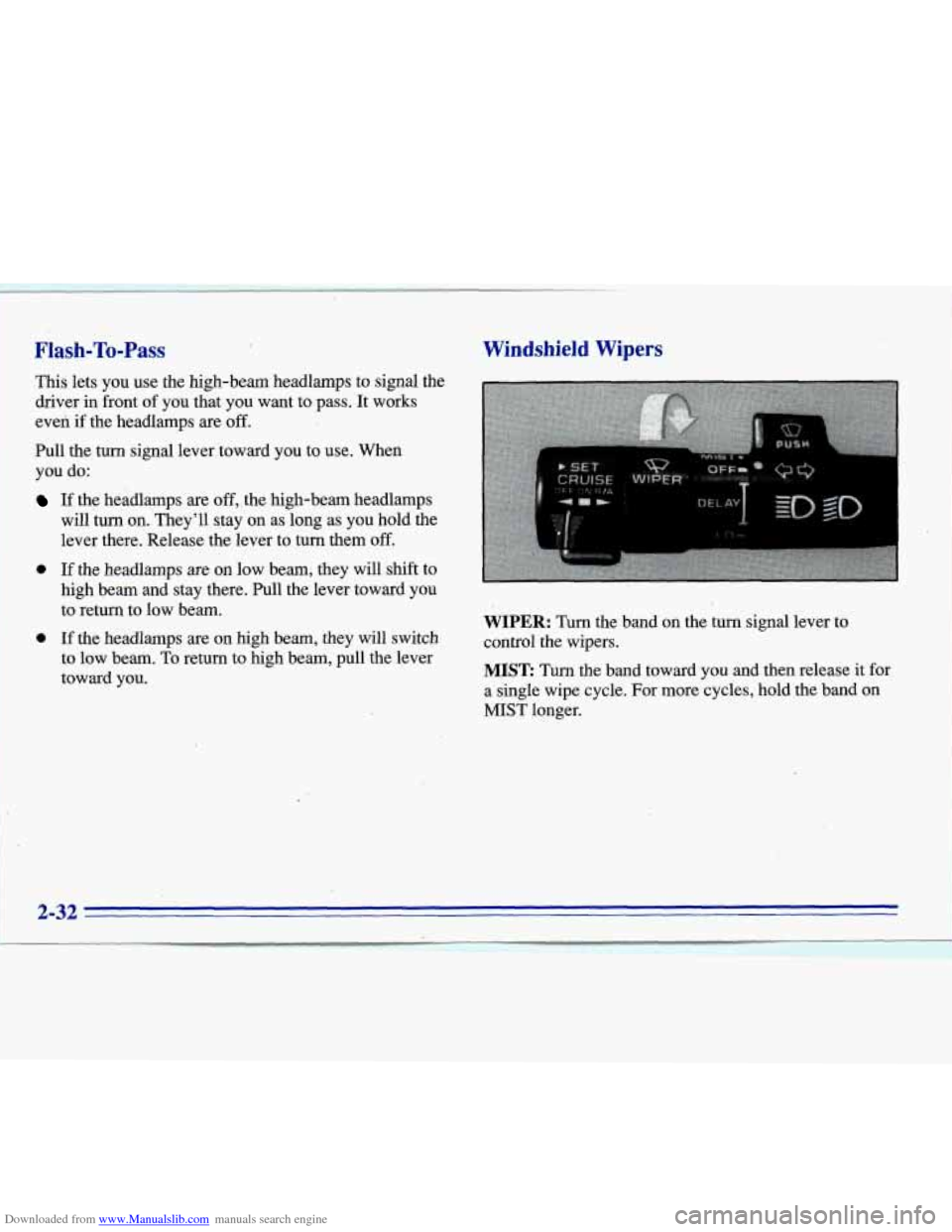
Downloaded from www.Manualslib.com manuals search engine Flash-To-Pass ,
This lets you use the high-beam headlamps to signal the
driver
in front of you that you-want to pass. It works
everi if tfie headlamps are off.
Pull the turn signal lever toward you to use. When
you do:
If the headlamps are off, the high-beam headlamps
will
'turn on. They'll stay on as long as you hold the
lever there. Release the lever
to turn them off.
0 If the headlamps are on low beam, they will shift to
high beam and stay there. Pull the lever toward you
to return
to low beam.
0 If the headlamps are on high beam, they will switch
to low beam. To return to high beam, pull the lever
toward you.
Windshield Wipers
WIPER: Turn the band on the turn signal lever to
control the wipers.
MIST: Turn the band toward you and then release it for
a single wipe cycle. For more cycles, hold the band on
MIST longer.
Page 101 of 354
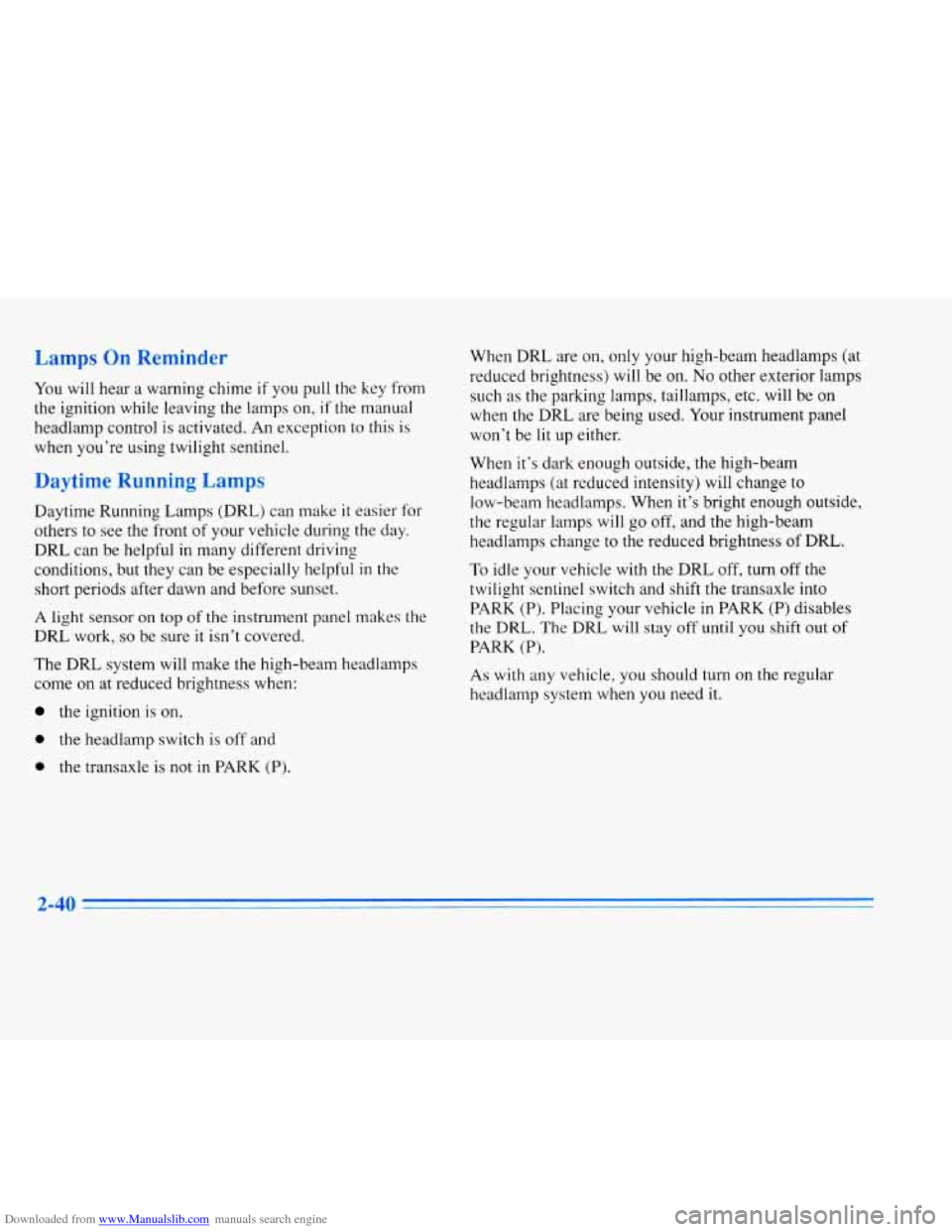
Downloaded from www.Manualslib.com manuals search engine Lamps On Reminder
You will hear a warning chime if you pull the key from
the ignition while leaving the lamps on,
if the manual
headlamp control is activated. An exception to this
is
when you’re using twilight sentinel.
Daytime Running Lamps
Daytime Running Lamps (DRL) can make it easier for
others to see the front of your vehicle during
the day.
DRL can be helpful in many different driving
conditions, but they can be especially helpful
in the
short periods after dawn and before sunset.
A light sensor on top of the instrument panel makes the
DRL work,
so be sure it isn’t covered.
The DRL system will make the high-beam headlamps
come on at reduced brightness when:
the ignition is on,
0 the headlamp switch is off and
0 the transaxle is not in PARK (P).
When DRL are on, only your high-beam headlamps (at
reduced brightness) will be on.
No other exterior lamps
such as the parking lamps, taillamps, etc. will be on
when the DRL are being used. Your instrument panel
won’t be
lit up either.
When it’s dark enough outside, the high-beam
headlamps (at reduced intensity) will change to
low-beam headlamps. When it’s bright enough outside,
the regular lamps will go off, and the high-beam
headlamps change to the reduced brightness of DRL.
To idle your vehicle with the DRL off, turn off the
twilight sentinel switch and shift the transaxle into
PARK (P). Placing your vehicle in PARK
(P) disables
the
DRL. The DRL will stay off until you shift out of
PARK (P).
As with any vehicle, you should turn on the regular
headlamp system when you need
it.
Page 102 of 354
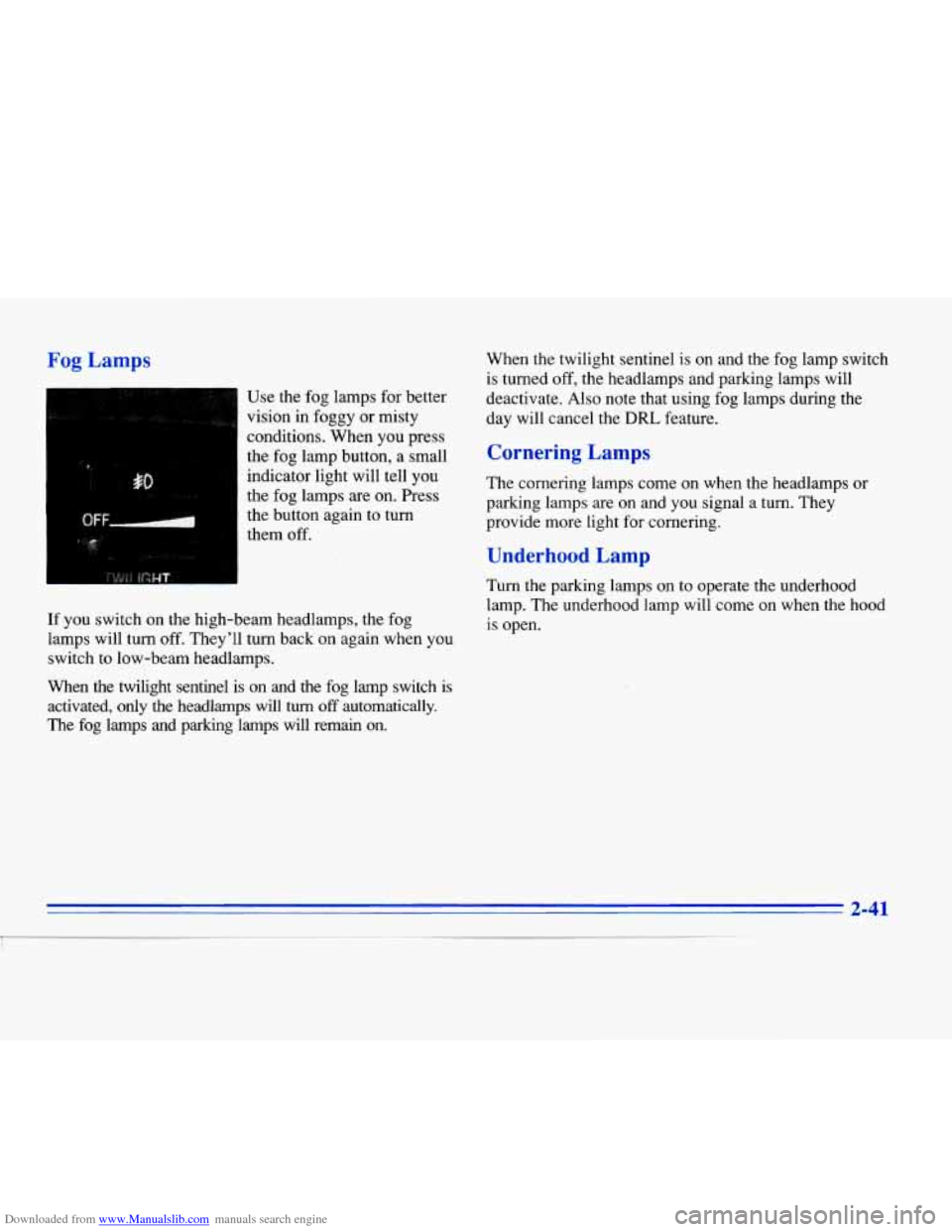
Downloaded from www.Manualslib.com manuals search engine Fog Lamps
Use the fog lamps for better
vision in foggy or misty
conditions. When you press
the fog lamp button, a small
indicator light will tell you
the fog lamps are on. Press
the button again to turn
them off. When the twilight sentinel is
on and
the fog lamp switch
is turned off, the headlamps and parking lamps will
deactivate.
Also note that using fog lamps during the
day will cancel the
DRL feature.
Cornering Lamps
The cornering lamps come on when the headlamps or
parking lamps are on and you signal a turn. They
provide more light for cornering.
Underhood Lamp
Turn the parking lamps on to operate the underhood
lamp. The underhood lamp will come on when the hood
If you switch on the high-beam headlamps, the fog is open.
lamps will turn off. They’ll turn back on again when you
switch to low-beam headlamps.
When the twilight sentinel is
on and the fog lamp switch is
activated,
only the headlamps will turn off automatically.
The fog lamps and parking lamps will remain on.
2-41
Page 199 of 354
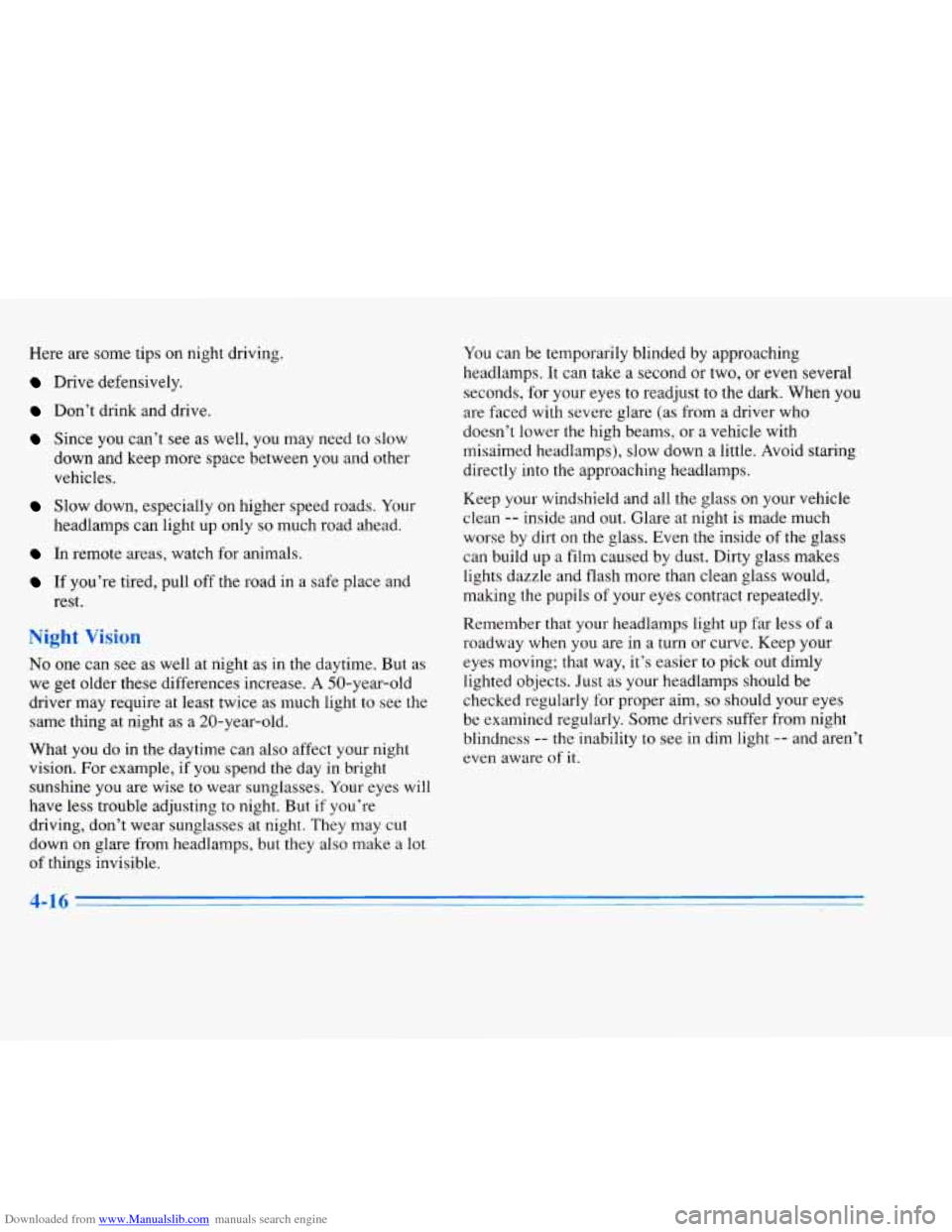
Downloaded from www.Manualslib.com manuals search engine Here are some tips on night driving.
Drive defensively.
Don’t drink and drive.
Since you can’t see as well, you may need to slow
down and keep more space between you and other
vehicles.
Slow down, especially on higher speed roads. Your
headlamps can light
up only so much road ahead.
In remote areas, watch for animals.
If you’re tired, pull off the road in a safe place and
rest.
Night ’
No one can see as well at night as in the daytime. But as
we get older these differences increase.
A 50-year-old
driver may require at least twice as much light to see the
same thing at night as a 20-year-old.
What
you do in the daytime can also affect your night
vision. For example,
if you spend the day in bright
sunshine you are wise to wear sunglasses. Your eyes
will
have less trouble adjusting to night. But if you’re
driving, don’t wear sunglasses at night. They may cut
down
on glare from headlamps, but they also make a lot
of things invisible. You
can be temporarily blinded by approaching
headlamps. It can take a second or two,
or even several
seconds, for your eyes to readjust to the dark. When
you
are faced with severe glare (as from a driver who
doesn’t lower the high beams, or a vehicle with
misaimed headlamps),
slow down a little. Avoid staring
directly into the approaching headlamps.
Keep your windshield and all the glass
on your vehicle
clean
-- inside and out. Glare at night is made much
worse by dirt on the glass. Even the inside of the glass
can build up a film caused by dust. Dirty glass makes
lights dazzle and flash more than clean glass would,
making the pupils
of your eyes contract repeatedly.
Remember
that your headlamps light up far less of a
roadway when you are in a turn or curve. Keep your
eyes moving; that way, it’s easier
to pick out dimly
lighted objects. Just as your headlamps should be
checked regularly for proper aim,
so should your eyes
be examined regularly. Some drivers suffer from night
blindness
-- the inability to see in dim light -- and aren’t
even aware of it.
4-16 -
Page 202 of 354
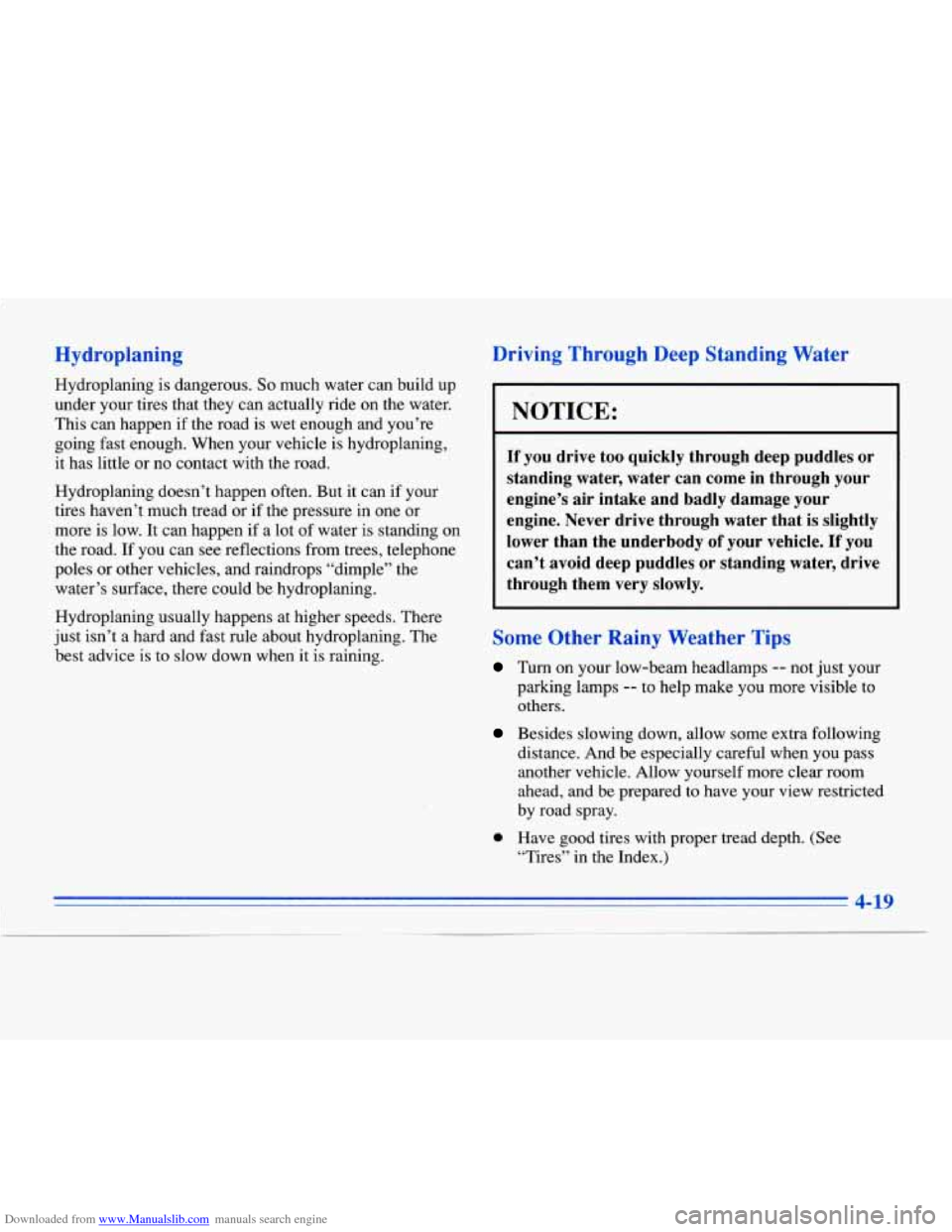
Downloaded from www.Manualslib.com manuals search engine Hydroplaning
Hydroplaning is dangerous. So much water can build up
under your tires that they can actually ride on the water.
This can happen if the road is wet enough and you’re
going fast enough. When your vehicle is hydroplaning,
it has little or no contact with the road.
Hydroplaning doesn’t happen often. But it can
if your
tires haven’t much tread or if the pressure in one or
more
is low. It can happen if a lot of water is standing on
the road. If you can see reflections from trees, telephone
poles or other vehicles, and raindrops “dimple” the
water’s surface, there could be hydroplaning.
Hydroplaning usually happens at higher speeds. There
just isn’t a hard and fast rule about hydroplaning. The
best advice is to slow down when it is raining.
Driving Through Deep Standing Water
NOTICE:
If you drive too quickly through deep puddles or
standing water, water can come in through your
engine’s air intake and badly damage your
engine. Never drive through water that
is slightly
lower than the underbody
of your vehicle. If you
can’t avoid deep puddles or standing water, drive
through them very slowly.
~~ ~
Some Other Rainy Weather Tips
Turn on your low-beam headlamps -- not just your
parking lamps
-- to help make you more visible to
others.
Besides slowing down, allow some extra following
distance. And be especially careful when you pass
another vehicle. Allow yourself more clear room
ahead, and be prepared to have your view restricted
by road spray.
0 Have good tires with proper tread depth. (See
“Tires” in the Index.)
4-19
Page 315 of 354

Downloaded from www.Manualslib.com manuals search engine INT LPS CIG LTAl
LHDLP Lo R HDLPLO LHDLPHI RHDLP HI SENSE
, HDLPS , I HAZARD I , STOP I I MIRROR , I FOGIDRL ,
IGN O(ENG) CRANK WIPERS
FUSE CENTER IDENTIFICATION
- - -
OXY SEN2 OXY SEN1 FUEL PUMP
CRUISE RELAY
DISTR PCM(IGN ECS ndn - ---
PCM BAT AIC COMP n& n I
AiC COMP RE LAY
FRONT OF VEHICLE 3648830 / I
--- I '/
Fuse Usage
INT LPS Trunk Lamp, Courtesy Lamps,
Front Vanity Lamps, Glove
Box
Lamp, Garage Door Opener,
Courtesy Lamp Relay
CTG LTRl Front Cigarette Lighter (Full
Console Only), Rear Lighter
L HDLP LO Left Low-Beam Headlamp
Fuse
R HDLP LO
L HDLP HI
R HDLP HI
SENSE
-
HDLPS
HAZARD
STOP
Usage
Right Low-Beam Headlamp,
Light Emitting Diode (LED) on
Headlamp Switch
Left High-Beam Headlamp
Right High-Beam Headlamp Heated Windshield Control
(Optional)
Headlamp Switch and Relay,
High/Low Beam Control Relay,
Right and Left
Low Beam (I-Beam),
Right and Left High Beam
Electronic Flasher Module,
Turn/Hazard Module, Right and Left Turn Lamps, Back-up Lamps, Right
and Left Front Turn Lamps, Right
and Left Repeater Lamps (Export)
Stoplamp Switch, Centered
High-Mounted Stoplamp
(CHMSL), Turn Hazard Switch,
ABS Controller. Stepper Motor
Cruise Control, Right and Left
Rear Stoplamps
Page 318 of 354

Downloaded from www.Manualslib.com manuals search engine Fuse
BODY 1
BODY 2
BODY 3
INADVERT
Usage
Real Time Dampening (RTD)
Fuse, Convenience Fuse, BATT
Fuse, Headlamp Wash Fuse
(Export), Antenna Fuse, Park
Lamp Relay, Right and Left
Park Fuse
Defog Relay, Pull-Down Fuse,
Right and Left Heated Seat Fuse,
Electronic Level Control (ELC)
Fuse, Rear Defog Fuse, Heated
Mirror Fuse
Controlled Power Relay,
Controlled Power Back-up Relay
Mirror Fuse, Platform Zone
Module (PZM) Fuse, Radiophone
Fuse, Cluster Fuse,
AMP Fuse
Comfort Fuse
Inadvertent Power Relay,
Brushless Blower Motor, Interior
Lamps Fuse, Cigarette Lighter
1 Fuse
Fuse
LAMPS
IGN
1
WINDOWS SEATS
BATT
3
Usage
Highbow Beam Relay, Headlamp
Relay, Fog Lamp/DRL Fuse, Hazard Fuse, Mirror Fuse,
Headlamp Fuse, Right and Left
High Beam Fuse, Right and Left
Low Beam Fuse, Stop Fuse
Rear Ignition-
1 Relay, Wiper
Fuse, Relay Ignition-
1 Fuse,
Supplemental Inflatable Restraint (SIR) Fuse
Delayed Accessory Bus (DAB)
Relay
Horn Relay, Driver and Passenger
Lumbar In/Out Relays, Driver and
Passenger Up/Down Relays,
Memory Seat Module, Driver and
Passenger Power Seat Switch
Ignition 0-Body Fuse, RTD Fuse,
Ignition 0-Engine Fuse, Anti-Lock
Brake System (ABS) Fuse, Turn
Fuse, Console